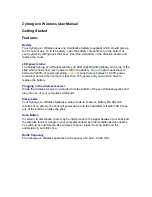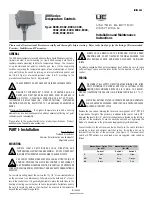
Instruction Manual
D100333X012
1069 Actuator
April 2018
10
Assembly
This procedure assumes that the actuator is completely disassembled. If the actuator is not completely disassembled,
start these instructions at the appropriate step. When assembling parts, make sure that all O‐rings are positioned
correctly as shown in figure 4 of the instruction manual. For ease of assembly, lubricate all O‐rings with lithium grease.
1. If the bearing (key 40) is removed, press in the new bearing. The end of the bearing should be flush with the bottom
of the recess in the mounting yoke (key 17).
2. Slide the mounting yoke over the valve shaft, and secure it to the valve with the valve mounting cap screws. Refer
to the appropriate valve body instruction manual for bolting torques for these cap screws.
CAUTION
Refer to table 2 for bolting torques of actuator bolts and cap screws. Exceeding any torque requirement may impair the
safe operation of the actuator.
3. To aid installation of the lever, apply lithium grease (key 45) to the exposed valve shaft spline. It may be necessary
to rotate the set screw (key 41) clockwise slightly to spread the split portion of the lever and allow installation on
the valve shaft.
4. Consult the appropriate valve body instruction manual for lever/valve shaft orientation marks and slide the lever
into place. Consult figure 3 for the appropriate lever operating clearances. When the lever is in place, back off the
set screw (key 41) so that the lever can be clamped onto the valve shaft. Secure the assembly with the cap screws
(key 20). Tighten the cap screws (key 20) to 271 N
S
m (200 lbf•ft).
5. Connect each rod end bearing to the lever with a cap screw and anti‐rotator assembly (keys 8 and 42). Cap screw
torques are listed in table 2. Tighten the cap screws (key 8) to 407 N
S
m (300 lbf•ft).
the mounting yoke with the cap screws (key 18).
7. Apply lithium grease (key 45) to the surface of both sliding seals (key 13) and thrust washers (key 36).
8. To install each cylinder flange, proceed as follows:
Lay the cylinder flange (key 2) upside down on a flat surface and then install each of the following parts in order: the
O‐ring (key 12), the sliding seal with installed O‐ring (keys 13 and 11), the thrust washer (key 36), and the seal support
cylinder (key 14). Then while holding the cylinder flange assembly together with both hands, turn the assembly over
and place it onto the housing. Temporarily rotate the cylinder flange to gain access to the three cap screw holes
located directly above the housing web and install three cap screws and washers (keys 3 and 69) into the appropriate
holes in the cylinder flange. Return the cylinder flange to its normal position and secure it to the housing with the cap
screws (key 16).
CAUTION
Use care when inserting each piston rod. Nicks or scratches in the exposed surfaces of either of the piston rods could
disrupt the sealing surfaces of the sliding seals and O‐rings (keys 13 and 11).
9. Insert each piston rod (key 6) through each sliding seal (key 13) and thread each rod into each rod end bearing (key
7), leaving approximately 3 or 4 threads of each piston rod exposed. Using a large wrench, grip the flats on the
bottom end of one of the piston rods, and then let the wrench stop against the actuator housing. Install a washer
(key 70), the piston (key 4) with attached O‐rings (keys 5 and 71), and another washer (key 70) to the piston rod.
Then, tighten the cap screw (key 43) against the piston. Remove the wrench and thread the piston rod completely


































